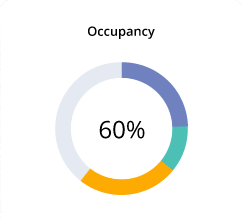Collaboration in the IoT era: Practical guidelines for a collaborative IoT
Given the diversity of fields and the currently fragmented state of IoT, there is an opening for other small players to enter the game. A deep dive into a particular segment, commercial buildings in this case, may illustrate more vividly an example of how it works and what it really takes to succeed.
Commercial buildings and the IoT
Building automation systems (BAS) are used in commercial buildings and traditionally include distinct services such as access control, HVAC, lighting controls, intruder alarms, video surveillance, fire detection and others. The big BAS players are Honeywell, Tyco (Johnson Controls), Schneider Electric and Siemens. The BAS approach, however, is now transforming into a buildings internet of things (BIoT), where higher resolution and rich actionable data gathered by smart sensors is shared by all services and controlled by centralized management systems to deliver a much greater value.
According to industry experts, the BIoT business is currently being driven by two quite opposing types of supply chains. One is a top-down approach led by the major communications and software IoT players and is characteristic in new construction projects. The other is a bottom-up type that includes suppliers of different technical services in buildings, from environmental controls to security and safety, and is more pertinent to retrofit projects. The bottom-up supply chain requires a close collaboration of different suppliers in order to collectively deliver viable BIoT solutions. Add that the potential size of the retrofit market is much larger than new construction projects and you get a clear indication of what the prudent entry point is for BIoT newcomers. A growing new market niche where no leadership has been established is a favorable environment for the smaller players.
In practice, this gets even better. Many building owners who consider “smartizing” their existing buildings are very much aware that IoT solutions are still in the early stage, and given the costs involved they take a wait-and-see position. Those that are more innovation-oriented and are willing to move forward take a cautious, risk-averse approach by adopting IoT slowly and gradually. They avoid taking the full BIoT package altogether and start small with a single IoT solution that addresses a particular use case with a clear ROI. This means that a small collaborative group with a few players can be a sufficient nucleus for establishing a foothold in the IoT domain. Thus, sensors/actuators vendors, application providers, networking and cloud specialists can team up and win specific retrofit projects.
Building the buildings’ building blocks
Assume a large enterprise (such as a bank, an accounting firm or an insurance company) is interested in saving money on real estate and cutting operating costs through optimizing space utilization. More specifically, the enterprise has identified hot desking and meeting room management as key use cases. An IoT solution that addresses these needs includes a smart sensor, data analytics, a supporting network and an application. These are the necessary building blocks. A group of selected vendors, each specializing in a specific aspect of the solution, can collaborate on a revenue-sharing basis and create an effective offering for this customer. Typically one of the team members takes the lead and coordinates the project with the customer on both technical and business levels. It may take an effort to ensure that all different pieces are seamlessly integrated and comply with the customer requirements. Beyond accurate and reliable performance, the various features of the solution — ranging from commissioning through security, privacy up to maintenance and upgradeability — must be implemented by the relevant team players.
Practical guidelines for collaboration
Whether you are a device vendor, an installer, a platform vendor or an application provider, the type of engagement between the various project partners can be rather flexible and on an ad hoc basis. In view of the fragmented nature of contemporary IoT, the diversity of ecosystems and the dynamic nature of collaborative groups, a few guidelines are highly important:
Interoperability — The end solution in general — and the particular building blocks that comprise it (device, application, networking) — must all support multiple communication protocols, security standards, commissioning processes, cloud-computing provisions and so on. Since end customers range from “digitally naive” to skilled professionals who have already selected their preferred technologies, the greater flexibility you have, the greater your chances are to team up with a variety of partners and to win a successful project.
Flexible design — An open API and the capability to add features in a timely manner are mandatory for both collaborative work and for winning successful projects.
Flexible business model — The IoT technology transformation is associated with changes in business models and shows a growing trend of moving away from selling commoditized units toward selling value-add products, applications and services. This trend, which is also reflected in moving from Capex to Opex, takes place very slowly, and end customers are often hesitant to adopt it. A flexible model that capitalizes on the real value (data) yet is palatable by conservative buyers is essential for closing deals.
Co-marketing — One of the immediate benefits of working in collaborative groups is the instant expansion of marketing channels for all participants. Leveraging the combined lists of customers is a force multiplier that can grow exponentially. Nevertheless, it requires openness, transparency and team work by all partners.
At this stage, there is a promising opening for various players to enter the IoT game through collaborative groups. As exemplified in the case of commercial buildings, companies that take the collaborative approach are in a better position to succeed with their IoT solution in whatever field they play.
All IoT Agenda network contributors are responsible for the content and accuracy of their posts. Opinions are of the writers and do not necessarily convey the thoughts of IoT Agenda.

